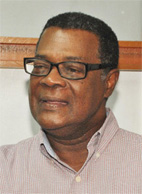Industry pressures arising out of what is now a pattern of falling gold prices is threatening to create further differences between privately run small and medium-scale gold mining operations and the state-run oversight body, the Guyana Geology and Mines Commission. (GGMC).
Speaking earlier this month at a forum convened to discuss a scoping study for the adoption of an Extractive Industries Transparency Initiative (EITI), Guyana Gold and Diamond Miners Asso-ciation (GGDMA) Presi-dent Patrick Harding said small and medium-scale miners want government to respond to reduced global gold prices and consequential reduced earnings from the sector by releasing information currently being held by the GGMC that would allow the miners easier access to gold-bearing areas.
“Miners can better service falling gold prices if the GGMC can release from its records exploration information highlighting the location of mineral deposits,” Harding said.

The issue of what miners have told this newspaper has been the refusal of the GGMC to provide such information to the sector now seems likely to precipitate a significant decline in gold production from the previously projected 2014 target of around 500,000 ounces.
The sector, it appears, continues to be less than satisfied with the extent of material support for the creation of conditions that enhance the conviviality of the industry for small and medium-scale miners and in his address Harding called for “greater technical and financial support to the small and medium-scale miners in the areas of property exploration and evaluation, improved gold recovery technology and the rehabilitation of mined out sites.”
Harding added that “even more important, in surviving the low gold prices, is the need to increase gold recovery from generally below 50% to over 75%.”
These issues and several others have created rifts between government and miners, not least being the interminable delay in the granting of key concessions to miners in the face of falling gold prices.
While Harding says the GGDMA is supportive of an EITI there are signs it could also be a bone of contention between government and the sector. Harding declared that, “the EITI is best suited to monitor the large-scale sector,” a reference to the foreign-owned mining entities that are expected to begin operations here next year. “We support the intended study on that basis and look forward to the results and recommendations,” Harding said.
Some miners have made clear their view that the proposed EITI may be another measure to facilitate the over-policing of the sector in the wake of what has become a circumstance of significantly heightened official suspicion regarding evasion of taxes and royalties. On this issue too Harding came down firmly on the side of small and medium-scale miners declaring that they “pay royalty and taxes… on gross production value of minerals; 5% of royalties and 2% income tax.” Harding said those payments amounted to “over $5 billion in royalties, and over $2 billion in direct income tax annually. “Ours is a matter of public record. We are mandated to submit production records, in a timely basis to the GGMC and GGB,” the GGDMA President added.





